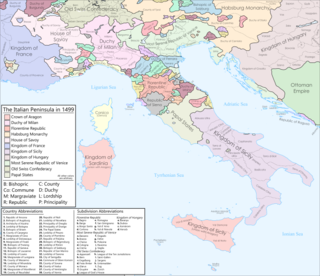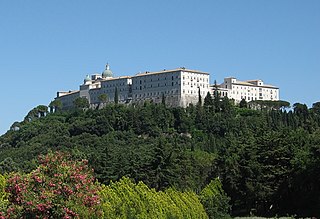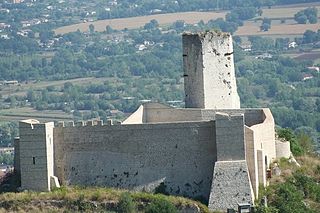Related Research Articles

Monte Cassino is a rocky hill about 130 kilometres (80 mi) southeast of Rome, in the Latin Valley, Italy, 2 kilometres west of Cassino and at an elevation of 520 m (1,710 ft). Site of the Roman town of Casinum, it is best known for its abbey, the first house of the Benedictine Order, having been established by Benedict of Nursia himself around 529. It was for the community of Monte Cassino that the Rule of Saint Benedict was composed.

The Italian city-states were numerous political and independent territorial entities that existed in the Italian Peninsula from the beginning of the Middle Ages until the proclamation of the Kingdom of Italy, which took place in 1861.

Saint Dominic, also known as Dominic of Osma and Dominic of Caleruega, often called Dominic de Guzmán and Domingo Félix de Guzmán, was a Castilian Catholic priest and founder of the Dominican Order. Dominic is the patron saint of astronomers.

The Duchy of Gaeta was an early medieval state centered on the coastal South Italian city of Gaeta. It began in the early ninth century as the local community began to grow autonomous as Byzantine power lagged in the Mediterranean and the peninsula due to Lombard and Saracen incursions.

Amatus of Montecassino, was a Benedictine monk of the Abbey of Montecassino who is best known for his historical chronicles of his era. His History of the Normans, is one of three principle primary sources for the Norman Conquest of southern Italy--the other two being the histories of William of Apulia and Geoffrey Malaterra. Amatus describes the Normans from the perspective of his abbey, one of the most important religious and cultural centers in Italy at the time. His history is the earliest extant account of the Norman sieges of Bari and Salerno, their conquest of Sicily, and the careers of both Robert Guiscard and Richard Drengot, as well as the Gregorian Reforms seen from the papal point of view.
Richard Drengot was the count of Aversa (1049–1078), prince of Capua and duke of Gaeta (1064–1078).
William of Montreuil, was an Italo-Norman freebooter of the mid-eleventh century who was briefly Duke of Gaeta. He was described by Amatus of Monte Cassino as "an exceptional knight, small in stature, who was very robust, strong, valiant" and by Orderic Vitalis as 'the good Norman'.
Richard III, also known as Richard of Caleno, was the Norman count of Carinola and last quasi-independent Duke of Gaeta, ruling from 1121 to his death. From 1113, he was regent of Gaeta for his cousin or nephew, Duke Jonathan; in 1121 he succeeded him. As duke he was a nominal vassal of the Princes of Capua, to whom he was related.

A cartulary or chartulary, also called pancarta or codex diplomaticus, is a medieval manuscript volume or roll (rotulus) containing transcriptions of original documents relating to the foundation, privileges, and legal rights of ecclesiastical establishments, municipal corporations, industrial associations, institutions of learning, or families. The term is sometimes also applied to collections of original documents bound in one volume or attached to one another so as to form a roll, as well as to custodians of such collections.

The Archdiocese of Gaeta is a Latin Church ecclesiastical territory or archdiocese of the Catholic Church in southern Italy, in the city of Gaeta, in the Lazio region. The archbishop's cathedra is located in the Cathedral of SS. Erasmus and Marcianus and the Assumption of the Virgin Mary in the episcopal see of Gaeta. A non-metropolitan see, the archdiocese is immediately exempt to the Holy See.

Campodimele is a town and comune in the province of Latina, in the Lazio region of central Italy. It is located on a steep Karstic hill, between the Monti Ausoni and Monti Aurunci ranges.

Santi Cosma e Damiano is a town and comune in the province of Latina, in the Lazio region of central Italy, whose territory is located partly in the Monti Aurunci area and partly in the Garigliano plain.

The Terra Sancti Benedicti was the secular territory, or seignory, of the powerful Abbey of Montecassino, the chief monastery of the Mezzogiorno and one of the first Western monasteries: founded by Benedict of Nursia himself, hence the name of its possessions. It lasted from the 8th to the 19th century.
Jonathan, a member of a cadet branch of the Drengot family, was the Duke of Gaeta from 1113 until his death. He is known from the Codex Caietanus to have been in the fourth year of his minority in 1116 and the seventh of his rule in 1119. There are three theories of his paternity. He may have been the son of Count Jonathan I of Carinola or his grandson by an unnamed son, or else the grandson of Count Bartholomew of Carinola. He was under the regency of his cousin or uncle, Count Richard of Carinola.
Gualganus, surnamed Ridel, was the third and last Count of Pontecorvo and Duke of Gaeta of the Norman Ridel family from about 1091 until about 1103. He was a son and successor of Duke Raynald Ridel, but his rule in Gaeta was not unopposed.
Hugh was the Count of Suio in the Duchy of Gaeta. He was probably a son of Docibilis magnificus, who in turn was probably a son of Landolf, son of Gregory, Duke of Gaeta, and Landolf's mistress Polyssena (Pulessene). He was a brother of Duke Leo II of Gaeta.
Bernard was the Bishop of Gaeta for fifty years from his appointment in 997 until his death. He was a member of the Docibilan dynasty which ruled the Duchy of Gaeta from 867 to 1032. During his long episcopate he achieved the economic security of his see in the face of labour difficulties, annexed the diocese of Traetto to his own in or soon after 999, and witnessed the decline and replacement of his family in Gaeta.

Gregory of Catino was a monk of the Abbey of Farfa and "one of the most accomplished monastic historians of his age." Gregory died shortly after 1130, possibly in 1133.

The Codex diplomaticus cavensis is an editorial project active in the field of the history of medieval Italy and Langobardia Minor, which began in 1873 and continued with an irregular trend. The project pursues the objective of exhaustive publication of the entire diplomatic and documentary corpus kept in the archive of the Benedictine Abbey of the Holy Trinity, located in Cava de 'Tirreni. The consistency of the archive spans over 15,000 parchments, starting with the first writing that dates back to 792. To this membranous patrimony there is to be added a substantial amount of documents on paper.
The Cesina family is an Italian family of Roman-Lombard origin.
References
- ↑ Guiraud (1982), 486: Pour ce cadre géographiquement restreint ... une relative abondance de sources.